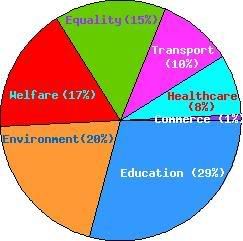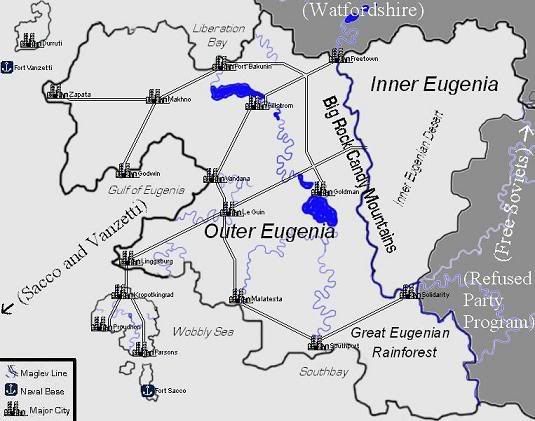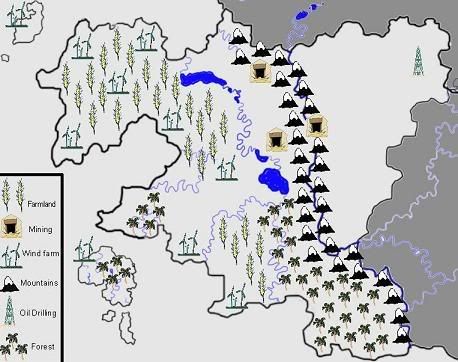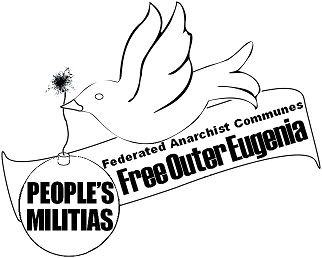Difference between revisions of "Free Outer Eugenia"
| Line 1: | Line 1: | ||
| + | {{NPOV}} | ||
| + | |||
{{Infobox Nation | | {{Infobox Nation | | ||
flag=http://www.nationstates.net/images/flags/uploads/free_outer_eugenia.jpg | | flag=http://www.nationstates.net/images/flags/uploads/free_outer_eugenia.jpg | | ||
Revision as of 06:11, 16 April 2007
- The neutrality of this article is disputed. Please see the article's talk page for more information before editing.
- Please do not remove this notice until consensus is reached.
| |||||
| Motto: Autonomy in Organization. | |||||

| |||||
| Region | Anarchy, Aperin | ||||
|---|---|---|---|---|---|
| Capital | None | ||||
| Largest city | Port Bakunin | ||||
| Official Language(s) | Eugenian, English, Spanish, others | ||||
| Government | Anarchist Federation | ||||
| - Industrial Councils | Urban and Rural Communes | ||||
| - Workplace Councils | Commune and Block Assemblies | ||||
| - Local Industrial Councils | Urban Communal Councils | ||||
| - All-Industrial Councils | Ecoregional Councils | ||||
| - Eugenian Federation of Workers | Federated Anarchist Communes | ||||
| Population | 40-60 million | ||||
| Currency | None | ||||
| NS Sunset XML | |||||
According to the U.N. Factbook, Free Outer Eugenia is a safe, environmentally stunning, socially progressive and economically powerful "Left Wing Utopia" notable for its complete lack of prisons, remarkable for its devotion to social welfare, and renowned for its 'strong anti-business politics' and complete absence of drug laws. The people of Free Outer Eugenia are described as 'intelligent, compassionate and hardworking.'
Contents
Geography
The Federated Anarchist Communes of Free Outer Eugenia are located in the Anarchist south of the continent of Lesser Aperin. Outer Eugenia is the southern neighbor of Watfordshire and it lies west of Inner Eugenia, Refused Party Program and the Anarchist Federation of Free Soviets. The islands of Sacco and Vanzetti lie 600 kilometers southwest from Outer Eugenia's shore. The Outer Eugenian climate is subtropical and it's most notable geographical features are the Big Rock Candy Mountains that mark Outer Eugenia's western frontier and the Great Eugenian Rain Forest in the south.
|
|
|---|
| Major Population Centers and Mass Transport in the Federated Anarchist Communes |
Transport System
The major population and industrial centers of Free Outer Eugenia are connected with magnetic levitation train lines. The maglev system allows quick and energy efficient movement of people and resources with minimal environmental impact.
Agriculture
All of Free Outer Eugenia's population centers are 'green cities.' Roof gardens, street orchards and community parks produce a good portion of the urban food supply. There is also however a rich and sparsely populated countryside whose population is chiefly devoted to agriculture. They work the land in in a sustainable way to produce the various grains, fruits and vegetables that are the staples of the Outer Eugenian diet. Their output not only supplements urban food production but also provides for Eugenian food exports.
Energy
Most of the electricity in Free Outer Eugenia comes from high performance wind, solar and geothermal plants and Biodiesel is Outer Eugenia's fuel of choice. The Biodiesel largely comes from local used cooking oil though some is imported.
Environment
Because of it's sustainable energy and transportation infrastructure as well as a commitment to polyculture-based farming, Free Outer Eugenia has made great strides toward healing from the ecological disaster of the colonial period. The Great Eugenian Rain Forest and the mountain ecosystems have been thriving in recent decades.
Inner Eugenia
|
|
|---|
| Natural Resources and Land Use in Free Outer Eugenia |
Inner Eugenia is a vast sandy desert east of the Big Rock Candy Mountains. It is populated by a number of nomadic tribes as well as several small communes. The tribes and communes of Inner Eugenia enjoy friendly relations with the Outer Eugenian Federation, and allow it full access to Inner Eugenia's plentiful oil reserves in exchange for the various fruits of Outer Eugenian industry and agriculture. Outer Eugenians use very little of this precious resource for fuel. A vast majority of the petroleum used by the Federated Anarchist Communes is utilized in the manufacture of advanced lubricants and plastics which are carefully recycled. The oil is transported through the Pan-Eugenian Pipeline that was originally laid during the later decades of Eugenia's colonial period.
History
Colonial Eugenia
Eugenia's first contact with a people that deemed the native Eugenian communalist subsistence culture to be 'primitive' occurred sometime in the 1540's. What followed was the usual pattern of false promises, greed, genocide and domination. The visitors brought empty treaties, smallpox laden blankets and square-jawed Jesuits who marched across the land with bible in one hand and sword in the other. Many Eugenians fell victim to the strange diseases that they brought. Many others died defending their land. Some retreated into the jungles, mountains and vast wastelands of Eugenia to take up a guerrilla war for land and liberty that would last for over 300 years. These freedom fighters were joined by bands of escaped slaves who were brought over from Africa to build and work the plantations that had been set up by the colonists.
As the stars of various imperial powers rose and fell, the old Spaniards were displaced by other masters but not much changed until the long sought after source of the gems used in Native Eugenian jewelry was found in the Big Rock Candy Mountains. It was then that the Scramble For Eugenia began in earnest. Many bitter wars were fought amongst the world's imperial powers, and a Free Outer Eugenian Republic was formed by rebel peasants, native insurgents and the various slave revolts in the ensuing chaos. The Free Republic lasted for the better part of a decade until the powers contending for control over Eugenia's resources came to an uneasy compromise. A 100-year monopoly over Eugenia was granted to an international cartel led by the notorious patent medicine conman turned railroad tycoon and beef magnate Augustus Kroc. Kroc then sent his ambitious son-in-law Tiberius at the head of an army of mercenaries and the soldiers of the various powers to take possession of his monopoly.
Faced with the ironclads, Gatling guns and other superior arms of an industrial war machine, the machete and musket wielding defenders of the Free Republic were brutally crushed. The rich planters who had fled Eugenia returned to their estates as another generation of freedom fighters retreated into the mountains and jungles.
Acting as an agent of Kroc Industrial, Tiberius Kroc (who had taken his father-in-law's name) employed slaves and indentured laborers to mine Eugenia's gems. As slavery fell out of favor in the world and early trade union movements began to win rights for waged labor, Kroc Industrial saw Eugenia as a lawless haven for the employment of slaves and waged semi-slaves to produce cheap goods for the world market. The discovery of oil and heavy metal deposits further spurred KI to develop Eugenia. Tiberius Kroc (who had become the head of KI after the death of his father-in-law) negotiated a 100 year extension on KI's monopoly and moved his corporate headquarters to a fortified base on Vanderbilt Island. He imported masses of impoverished workers to fuel the industrial machine of his corporate fiefdom.With them was bought the germ of revolutionary syndicalism and anarchism. These, along with the native communalist tradition were the seeds of Eugenia's ultimate liberation.
Revolution and Liberation
|
|
|---|
The Federation of Free Outer Eugenia was formed nine decades ago after the workers of Port Bakunin (then known as New Krocsport) aided by a group of their Shiree comrades expelled the cartel of transnational corporations that had been the unchecked exploiters and oppressors of the people of Outer Eugenia.
The revolution continued for the next fifty years until the whole of Outer Eugenia had thrown off the yoke of corporate imperialism, though the old regime had been largely contained in a diminishing sphere of control around Fort Vanderbilt (later renamed Fort Vanzetti) for forty-two years. The revolution was fueled by a fusion of an underground syndicalist labor union (the Eugenian Federation of Workers) that had formed during the years of industrialization and the native uprisings that had been raging since the early years of colonization. The traditional consensus-based collectivism of the Native Eugenians and the anarchist syndicalism of the EFW formed the foundation of the post-revolutionary order.
The Eugenian Social Revolution then spread across the region giving rise to the Anarchist Federation of Free Soviets and the libertarian socialist order of the islands now known as Sacco and Vanzetti.
Education
Education in Free Outer Eugenia is a lifelong process, though there are no schools or universities in the conventional sense. Everyone in the Federation is both teacher and student. Every commune has various open educational collectives where all sorts of skills are shared. All Outer Eugenians have some training in both the arts and essential labor functions as well as various forms of personal defense and defensive guerrilla warfare.
Outer Eugenians are generally fluent in four or five langueges. The Federation has no official language though Eugenian, English, and Spanish are spoken by most.
The Francisco Ferrer University at Port Bakunin
Sometimes called simply The University of Port Bakunin, The Francisco Ferrer University was founded by a collective of artists, poets, engineers and philosophers shortly after the revolution to advance the prorogation of the arts and sciences amongst the workers of the Federation. It is for the most part the University that makes Port Bakunin the cultural and intellectual center of Free Outer Eugenia. although there are many other great educational collectives in the Federation, most Outer Eugenians (as well as many students from abroad) spend at least a year or two as a part of the University.
Economic, Political and Social Order
The Federation has never been a true 'government' but rather a free and ultimately democratic partnership of individual communes and productive associations. It has provided a structure that eradicates the perceived need to maintain order through an imposed hierarchy. Through the Federation the people of Free Outer Eugenia have made sure so that no individual or group could garner enough power to impose tyranny over the land and the people.
Political Organization
The primary structural principles of the Federation are federalism, Syndicalism, bottom-up rule, consensus based decision-making, and free association or 'the right of secession.'
The Federation is ruled from the bottom up by the people who make up the productive associations and communes which in turn make up Ecoregions and Industries which are united under the Federation. The constituent organizations send their elected delegates to the Federal bodies.
The delegates may be recalled at any time and are only empowered to relay the decisions made by their constituencies to a convention of delegates with similar mandates. All resolutions made within a body of delegates are sent directly to the various constituencies for final approval, rejection or amendment.
Associations working in the same industrial line of production form Industrial Syndicates within the Federation. Immediately interdependent productive associations are structurally organized for particularly close and streamlined cooperation within each Syndicate. All Syndicates also cooperate closely with one another and many productive associations (especially those involved in the procurement and processing of raw materials) are active in several Syndicates at once. The lines differentiating the Syndicates are never straight or clear- the Syndicalist structure is an organic one based only on expediency, egalitarianism and free association. The Transportation Communication and Distribution Workers' Union is a particularly extreme case. A long heated and pedantic scholarly debate at the Ferrer University about whether the TCDU is indeed a Syndicate, or just a byproduct of the constant stream of associations between the Syndicates was laid to rest by an exclamation made by a bewildered first-year student: "But that's the same damned thing!"
Decisions on all levels of the Federation- from the election of a delegate to the approval of a production plan- are made by consensus.
All bodies- from a Sunday pear-picking collective in Freetown to the Federation itself- are formed and maintained by the free association of individuals and communities. No association is bound by anything but the wills and necessities of the individuals that comprise it. All of these associations are free and natural and are thus stronger and more productive than any externally imposed structure can ever be.
Economic Organization
Any Free Outer Eugenian productive association is entitled to the right to direct and control its production and to dispose of the fruits of its labor as the workers see fit. This has made all attempts to impose the brutal slavery known in much of the world under the euphemism of 'free enterprise' on the people of Free Outer Eugenia utterly futile.
Every adult (The definition of adulthood varies from commune to commune. The threshold generally lies somewhere between the age of fifteen and eighteen.) member of Free Outer Eugenian society participates in several of the many activities absolutely necessary to run the essential industrial and agricultural production and infrastructure of the Federated Anarchist Communes. This generally amounts to an average fifteen-hour workweek. The people of Free Outer Eugenia spend the rest of their time studying various fields of personal interest, engaging in many sorts of creative labor and generally enjoying all that a free, comfortable and stimulating life has to offer. Because of this the Outer Eugenian GDP is not a very good indicator of either the quality of life or the productiveness of the people of the Federated Anarchist Communes.
As the Federation economy functions on a mutual aid basis, the production plans of the workers' associations are informed by the needs of other productive associations and the communes. Though the educated opinions of various experts and academic collectives are often taken into consideration by the productive associations and communes, these learned savants act only in an advisory capacity. The economy of the Federation is certainly not centralized, but it is both planned and non-competitive.

|
|---|
Resource and Labor Distribution
This is a graphical representation of the Federation's general economic priorities. It has been specifically designed to fit the several standard UN categories of 'government spending.' As Free Outer Eugenia has neither a government nor a cash economy, the percentages indicate approximate assessments of the distribution of the Federation's resources and labor power. The various forms of industrial, agricultural and energy production are divided between 'Environment' 'Social Welfare' and 'Social Equality.' 'Commerce' encompasses the distribution of various personal goods within the communes. The transport and distribution of communal resources as well as any transport of goods and resources between communes falls under 'Transport.' 'Transport' also encompasses various forms of personal transportation.
Exports
The Federated Anarchist Communes participate in the CACE and IFTA. Most of Free Outer Eugenia's exports are cultural products such as music, software, fine art and craft items and literature. The Federation also exports certain choice agricultural and mass-manufactured products and a small amount of copper, zinc and gems.
The People's Militias
|
|
|---|
Free Outer Eugenia has no standing army- the gains of the revolution are defended by a confederation of local militias. These militias function much like the rest of Free Outer Eugenian society: there are no officers and discipline is self imposed. Combat leadership and coordination roles are preformed by delegates who are elected by consensus. Every member of the Federation over the age of 15 receives militia training.
International Brigades
The International Brigades are collectives within the People's Militias that provide assistance to various workers' struggles outside of Free Outer Eugenia. Members of the International Brigades are the most skilled and experienced fighters in the Federation.






